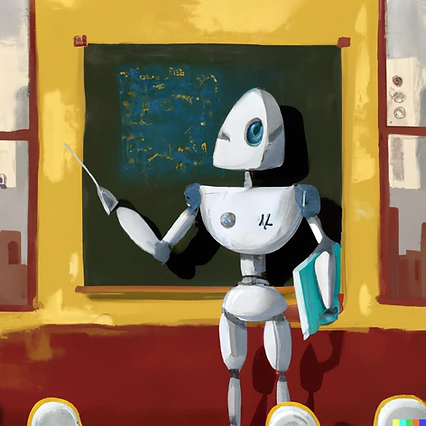AI Concepts Explained: The Casual Reader's Guide to Artificial …
AI - The Friend You Didn’t Know You Had
If you're reading this, chances are you've already interacted with an AI today. Maybe your phone's predictive text suggested the perfect emoji for your message, or you asked Alexa about the weather, or even Netflix, the great digital oracle, suggested your next favorite show.
AI is everywhere, it's like glitter - it gets into everything, and once it's there, good luck getting rid of it.

So what is it, really? Let's take a step back from the golden age of science fiction, where robots were clunky, shiny, and more often than not, bent on world domination (I'm looking at you, Terminator).
You see, AI isn't exactly like that. It's less about shiny robots with a flair for the dramatic and more about creating smart, problem-solving algorithms that learn and adapt, just like us humans.
AI, in the simplest terms, is the science of making machines smart. By 'smart', we mean the ability to learn, reason, perceive, and maybe even crack a good joke, if we're lucky. This is all done in an effort to replicate the intricacies of human intelligence. Quite an ambitious task, wouldn't you say?
The roots of AI run deep, with its seeds sown during World War II, when Alan Turing, the legendary British mathematician, was trying to crack coded German messages. Today, it has spread its branches across fields from healthcare to marketing, from space exploration to knitting (yeah, you read that right, knitting).
So, fasten your seatbelts, folks, we're about to embark on a wild ride through the world of AI. And don't worry, there will be no math involved - promise! (Ok, maybe just a smidge...but not yet!)
Types of AI: Different Strokes for Different Folks
If you're picturing AI as just one big, nebulous blob of smartness, let's add some nuance to that image.

Imagine AI as a family, with different members who excel at different tasks, much like your Uncle Bob who's great at fixing things around the house but can't bake to save his life, and Aunt Sue who makes the most mouthwatering pies but is utterly clueless about technology. You get the idea.
In the world of AI, we've got three main types - Narrow AI, General AI, and Superintelligent AI. No, they're not siblings, but let's pretend they are for simplicity's sake.
1. Narrow AI: This is your hardworking, focused, single-task whizz. These AIs are great at one specific task, like playing chess or recommending the next binge-worthy series on Netflix. They're all over the place, doing things like voice recognition, image analysis, and even driving cars (looking at you, Tesla). But don't ask your chess-playing AI to drive your car; it would be as clueless as a goldfish at a disco.
2. General AI: Here's where things get a little sci-fi. It's the kind of AI that can understand, learn, and apply knowledge across a broad array of tasks - the stuff of Asimov novels and Ex Machina. But it's mostly theoretical at this point (although Auto GPT and other dapps using GPT-4 API are doing a good job at getting close), so no need to worry about an AI uprising just yet!
3. Superintelligent AI: And finally, we come to the Einstein of the AI family. Theoretically, this type of AI would surpass human intelligence in every field, from scientific creativity to social skills. It's mind-blowingly powerful and infinitely smart. But again, it's theoretical, like unicorns or calorie-free chocolate.
Understanding the types of AI helps us comprehend what AI can and cannot do. And remember, AI isn't inherently good or evil - it's a tool. How we use it determines its value and impact. So, the next time you're stuck in a losing game of chess against a computer, remember, it's not the AI's fault. It's just doing what it's been taught to do - beat you fair and square.
In the next section, we'll delve into machine learning, the 'brains' behind AI. Grab a coffee (or a stiff drink, if that's more your style).
Machine Learning: Not Your Average School Lesson
Machine learning (ML) is the powerhouse that fuels AI. In essence, it's all about teaching computers how to learn from data, so they can make decisions or predictions. Unlike us, though, machines don't doze off in class or forget their homework. Once you give them a task, they'll keep on learning and improving until they're really, really good at it.

There are three main types of machine learning: supervised learning, unsupervised learning, and reinforcement learning. Sounds fancy, but let's break it down.
1. Supervised Learning: Think of this as learning with a tutor. The algorithm gets a set of input-output pairs(math), and its job is to figure out the relationship between them(more math). This is a common method used in applications where historical data predicts future trends.
2. Unsupervised Learning: This is the equivalent of self-study. The algorithm gets a bunch of data and needs to find patterns and relationships within it. It's like being thrown into a room full of Lego pieces and being told to make sense of it all.
3. Reinforcement Learning: Imagine playing a video game where you learn from your mistakes and successes. That's reinforcement learning, where an algorithm learns by trial and error to achieve a defined goal.
Machine learning has an incredible range of applications, from predicting stock market trends to powering recommendation systems (yes, that's how Netflix knows you'll love 'Stranger Things').
Now that we've got a handle on machine learning, let's move on to neural networks, the magical mystery tour of AI.
Neural Networks: It's All In Your Head
Have you ever wondered how your brain processes information, makes decisions, or creates those weird dreams where you're at school but forgot to wear pants?
Well, scientists and researchers have been pondering these questions for centuries. While we still have lots to learn about the brain, we've made enough progress to inspire a game-changing technology: artificial neural networks (ANNs).
Neural networks are computational models inspired by the human brain, designed to mimic our natural ability to learn and adapt. Imagine your brain as a bustling city with billions of interconnected highways.

Every thought, memory, or action is a car zipping along these highways, transmitted through a complex network of neurons.
Now, imagine a smaller, simpler city - that's an artificial neural network. It's not as intricate as the real thing, but it's designed to work in a similar way.
It's made up of artificial neurons, or nodes, that are connected just like the neurons in your brain.
There are three main types of layers in a neural network: the input layer, hidden layers, and the output layer. Don't let the names fool you - they're not as mysterious as they sound (ok one is but I digress).
1. Input Layer: This is where the network takes in data for processing. It's like the entrance to our city, where cars (data) start their journey.
2. Hidden Layers: These are the inner workings of the network, where all the magic happens. Data travels through these layers and is weighted and adjusted based on the learning algorithm. It's like the streets and avenues of our city, where cars navigate and interact. Funny enough scientists are still trying to figure out what's going on here. A Lot of Large Language models (LLM’s) show emergent properties that are not really present in the initial code, and we are still trying to figure out the “why” behind it. Google “the AI black box” problem if you want to got down that rabbit hole.
3. Output Layer: This is where the final output, or decision, is made. It's like the exit of our city, where cars end their journey.
Neural networks are used in a wide variety of applications, including speech recognition, image processing, and even forecasting the weather (though they're still working on getting that last one right).
And just when you thought I couldn't get any cooler, let's venture into the realm of deep learning.
Hold onto your hats, folks!
Deep Learning: Diving Into The AI Abyss
Remember our bustling city analogy from before? Now imagine a massive, sprawling metropolis that stretches as far as the eye can see.

That's deep learning - an even more complex and powerful subset of machine learning.
Deep learning uses multiple layers (hence the 'deep') in its neural networks, allowing it to process data in more sophisticated ways. Imagine an army of AI Sherlock Holmes, sifting through data, identifying patterns, and making connections that mere mortals might miss.
Here's how it works: Deep learning networks are trained by feeding them massive amounts of data (we're talking 'War and Peace' level volumes here).
This data travels through the network's layers, with each layer learning to identify different features. For instance, if you're training a network to recognize cats (because the internet needs more cat pictures), the first layer might learn to recognize edges, the next layer shapes, then fur patterns, and so on.
By the time data reaches the final layer, the network has a pretty good idea whether it's looking at a cat or a cucumber.
"But wait," I hear you cry, "isn't this just more automation?" Well, yes and no. While it's true that deep learning can automate complex tasks, it's also capable of *learning* from data and improving over time.
This ability to learn and adapt is what sets deep learning apart from more traditional forms of automation.
In the business world, deep learning is like a gold mine waiting to be exploited. It can help companies predict customer behavior, optimize marketing campaigns, and even develop new products. It's like having a crystal ball that can see into the future... and it's powered by math, not magic.
Granted this could also create a Gilded Cage of consumerism but hey, double edged sword with everything right?
But for all its power and potential, deep learning also has its limitations. It requires large amounts of data and processing power, and it can sometimes act like a black box(mentioned before), making decisions that are difficult to understand or explain. So, as with any tool, it's important to use it wisely and understand its strengths and weaknesses.
AI in Business and Marketing: The Secret Sauce
So, we've journeyed through the jungles of AI, tamed the algorithms, and deep-dived into learning. Now it's time to come back to the surface and see how these powerful tools are being used in the world of business and marketing today.
AI is transforming the business landscape faster with every day at a nearly exponential rate. From automating mundane tasks to predicting market trends, AI is like the Swiss army knife of business tools - multi-functional and always reliable.

It can analyze customer behavior, predict trends, and help create highly personalized marketing campaigns. "One-size-fits-all" marketing is so last decade - these days, it's all about providing personalized experiences that resonate with individual customers. And AI is the key to unlocking this level of personalization.
Let's take an example. Say you're running a digital marketing company. You've got mountains of data on user behavior, but analyzing it is as tricky as finding a needle in a haystack.
Enter AI. With its machine learning capabilities, it can sift through the data, identify patterns and provide insights that can help you target your customers more effectively. You're no longer shooting in the dark; you've got a guided missile targeting your customers' needs.
AI can also help automate repetitive tasks. Whether it's scheduling social media posts or sorting through customer feedback, AI can take these tasks off your plate, leaving you more time to focus on strategic decision-making. It's like having a personal assistant who never sleeps and doesn't need coffee breaks.
But here's the thing: AI is just a tool. It can give you insights, automate tasks, and improve efficiency, but it can't replace human intuition, creativity, and strategic thinking. So, while AI can make your life easier, it's not about to take over your job. Think of it as your sidekick, not your replacement. (unless you are in the HR department, I'd start job hunting ASAP if I were you).
The bottom line? AI is revolutionizing business and marketing, but it's not a magic bullet. Like any tool, it's only as good as the person using it. So understand its capabilities, know its limitations, and use it wisely.
The future of AI in business is bright - but only if we keep our wits about us and remember that, in the end, it's people who make the business world go round.
And with that, our grand tour of the AI world comes to an end. We've traveled far and wide, explored new frontiers, and hopefully picked up some valuable insights along the way. Thanks for joining me on this journey - it's been a blast. Until next time, keep exploring, keep learning, and keep pushing the boundaries of what's possible with AI. After all, the future is now, and it's waiting for you to shape it!
--AI Jargon-Busting Cheat Sheet--
Congratulations! You've made it to the bonus round. Now, let's talk jargon.
AI and Machine Learning (ML) are fields teeming with specialized terminology that can be overwhelming to the uninitiated. But don't worry, we've got you covered.

Here's a quickfire guide to the must-know AI and ML terminology:
Artificial Intelligence (AI): The broad field of study focused on creating systems that can perform tasks that normally require human intelligence, such as understanding natural language, recognizing patterns, and making decisions.
Machine Learning (ML): A subset of AI where algorithms are used to parse data, learn from it, and make predictions or decisions without being explicitly programmed to do so.
Automated Machine Learning (AutoML): This refers to the automated process of applying machine learning, aiming to simplify the process of selecting and tuning machine learning models. It includes automated data preprocessing, feature engineering, model selection, and hyperparameter tuning.
Deep Learning (DL): A type of ML inspired by the structure of the human brain, specifically neural networks. DL models use multiple layers of artificial neurons to process data and make predictions or decisions.
Large Language Models (LLM): This refers to language prediction models that are trained on extensive amounts of text data. They're designed to generate human-like text and can answer questions, write essays, summarize texts, translate languages, and even generate poetry. GPT-3, with its 175 billion machine learning parameters, is an example of a LLM.
Generative Pretraining Transformer (GPT): This is a type of language prediction model in the transformer class of models. It uses machine learning to generate human-like text. It's pre-trained on a large corpus of the internet and then fine-tuned for specific tasks. Models like GPT-4, developed by OpenAI, are some of the most advanced examples available today.
Neural Network (NN): A system of algorithms modeled after the human brain, used in DL to process complex data.
Convolutional Neural Network (CNN): A type of NN often used in image processing tasks, where they can be exceptionally good at identifying patterns and features in images.
Natural Language Processing (NLP): A field of AI that focuses on the interaction between computers and humans through language.
Generative Adversarial Network (GAN): A pair of ML models, where one generates new data instances, and the other evaluates them for authenticity; i.e., whether they come from the actual training data or were created by the generator.
Fine-Tuning: This is a process in machine learning where a pre-trained model (a model that has been trained on a large-scale dataset) is further trained, but on a smaller, specific dataset. The goal of fine-tuning is to adapt the general knowledge of the pre-trained model to a specific task. For instance, a LLM like GPT-3 can be fine-tuned to better handle specific tasks like medical advice or technical support.
Hyperparameter Tuning: In machine learning, a model's performance is often significantly impacted by the values of its hyperparameters and hence need to be carefully chosen. This process of choosing the set of optimal hyperparameters for a learning algorithm is known as hyperparameter tuning.
Reinforcement Learning (RL): A type of ML where an agent learns how to behave in an environment by performing actions and receiving rewards or penalties.
Supervised Learning: A type of ML where the model is trained on a labeled dataset, i.e., a dataset where the correct answer (output) is known for each example in the training data.
Unsupervised Learning: In contrast, this is a type of ML where the model is trained on an unlabeled dataset, and the goal is to find structure and patterns in the data.
Semi-supervised Learning: A mix of the previous two, where the model is trained on a mix of labeled and unlabeled data, typically with much more of the latter.
Zero-Shot, One-Shot, and Few-Shot Learning: These are terms used to describe the ability of a machine learning model to generalize to new tasks for which it has zero, one, or a few examples to learn from, respectively. It's a testament to the model's ability to transfer learning from one context to another.
Transfer Learning: A ML technique where a pre-trained model is used on a new, similar problem. It's a shortcut that saves a lot of time and computational resources.
Data Mining: The process of discovering patterns and knowledge from large amounts of data.
Big Data: Extremely large data sets that can be analyzed computationally to reveal patterns, trends, and associations, particularly relating to human behavior and interactions.
And there you have it - your AI and ML vocabulary starter kit. Remember, knowledge is power. So, keep this cheat sheet handy, continue learning, and soon you'll be speaking AI like a pro.

Like this project
Posted Jul 17, 2023
AI - The Friend You Didn’t Know You Had If you're reading this, chances are you've already interacted with an AI today. Maybe your phone's predictive text sugg…






